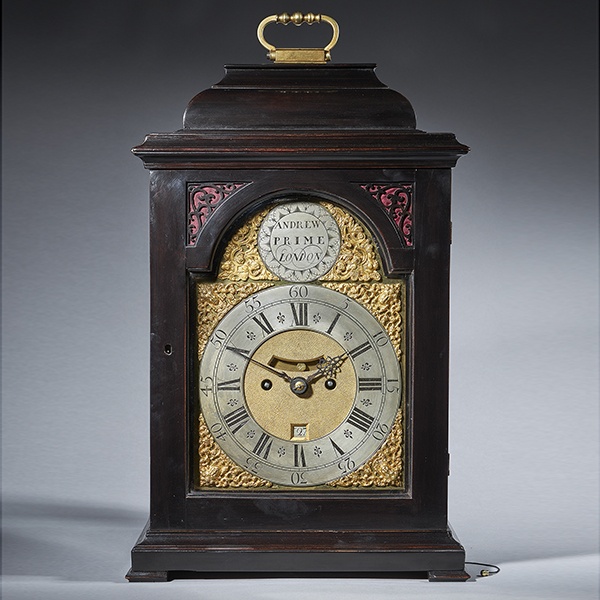19th Century Gilt-Brass Engraved Striking and Repeating Carriage Clock
Sold
Request Information
Follow Us
19th Century Gilt-Brass Engraved Striking and Repeating Carriage Clock
The superb engraved gilt brass gorge case has facetted glass panels to all sides so that the movement is almost entirely visible. The top has an oval window set in an engraved mask through which the original silvered platform escapement can be seen. At the back, there is a door giving access to the winding and setting arbors. The clock is surmounted by a typically shaped carrying handle.
The circular enamel dial is set in a fine elaborately engraved gilt-brass mask and has a Roman chapter ring with an outer minute track with five-minute markers. The time is indicated by a fine pair of blued-steel Breguet hands. The retailer has marked the dial in the following manner: G. WADHAM BATH.
The spring-driven eight-day movement of this charming clock is constructed between plates. It consists of going and striking trains. The going train has an English lever escapement on a silvered platform with hairspring balance and regulation. It can be adjusted by a regulator pin which can be seen through the window in the top and is accessible through the back door. The striking indicates the hour fully and the half hours with a single stroke on a bell. In addition, it has a repeat button at the top, with which the last hour struck can be repeated at will. The backplate is marked with the word hands and an arrow to indicate the function of the arbor and the direction in which to turn.
Note on the retailer
George Wadham was active in the period 1846-1878. He also sold watches and barometers.
Condition
Excellent. The movement keeps exceptional time and has been fully serviced by our horologist.
Provenance
Literature
Dimensions
H 14.5 cm x W 7.5 cm x D 6.5 cm
PREVIOUSLY SOLD
No Results Found
The page you requested could not be found. Try refining your search, or use the navigation above to locate the post.
No Results Found
The page you requested could not be found. Try refining your search, or use the navigation above to locate the post.
YOU MAY ALSO LIKE

Fine George III 18th Century Period Mahogany Longcase Clock by Tomas Fowle
18th Century Period Mahogany Longcase Clock by Tomas Fowle £12,995 Follow Us18th Century Period Mahogany Longcase Clock by Tomas Fowle A fine George III period mahogany longcase clock of excellent colour, patination and proportions, circa...

Fine Ebonized George II Eight Day Table Clock with Dutch Striking and Trip Rep
Fine Ebonized George II Eight Day Table Clock with Dutch Striking and Trip Rep £14,900 Follow UsFine Ebonized George II Eight Day Table Clock with Dutch Striking and Trip Rep By the highly regarded maker Andrew Prime. Andrew Prime, was...

17th Century Figured Walnut and Seaweed Marquetry Lace Box
17th Century Figured Walnut and Seaweed Marquetry Lace Box £3,600 Follow Us17th Century Figured Walnut and Seaweed Marquetry Lace Box A fine and extremely rare figured walnut and seaweed marquetry 'lace box', circa.... let’s break it down -...

19th Century Repeating Gilt-Brass Carriage Clock by the Famous Drocourt
19th Century Repeating Gilt-Brass Carriage Clock by the Famous Drocourt £5,600 Follow Us19th Century Repeating Gilt-Brass Carriage Clock by the Famous Drocourt A superb repeating carriage clock with a gilt-brass gorge case by the famous maker...

17th-Century Hague Clock Signed by Pieter Visbagh, circa 1675
Small 17th Century Hague clock made c. 1675 by Pieter Visbagh, who was apprenticed by Salomon Coster. The latter made the first pendulum clock according to the instructions of Christiaan Huygens, the internationally renowned scientist who developed the idea of applying a pendulum to a clock movement.

Pair of 18th-Century English Rococo Gilt Bronze Andirons or Firedogs
An exceptional pair of 18th century English Rococo gilt bronze andirons or fire dogs.
The bold shape of these andirons relate to designs of Thomas Johnson (1714–1778), one of London’s pioneers of the ‘Modern’ or French style, later known as Rococo.

Fine George III 18th Century Period Mahogany Longcase Clock by Tomas Fowle
18th Century Period Mahogany Longcase Clock by Tomas Fowle £12,995 Follow Us18th Century Period Mahogany Longcase Clock by Tomas Fowle A fine George III period mahogany longcase clock of excellent colour, patination and proportions, circa...

Fine Ebonized George II Eight Day Table Clock with Dutch Striking and Trip Rep
Fine Ebonized George II Eight Day Table Clock with Dutch Striking and Trip Rep £14,900 Follow UsFine Ebonized George II Eight Day Table Clock with Dutch Striking and Trip Rep By the highly regarded maker Andrew Prime. Andrew Prime, was...

17th Century Figured Walnut and Seaweed Marquetry Lace Box
17th Century Figured Walnut and Seaweed Marquetry Lace Box £3,600 Follow Us17th Century Figured Walnut and Seaweed Marquetry Lace Box A fine and extremely rare figured walnut and seaweed marquetry 'lace box', circa.... let’s break it down -...

19th Century Repeating Gilt-Brass Carriage Clock by the Famous Drocourt
19th Century Repeating Gilt-Brass Carriage Clock by the Famous Drocourt £5,600 Follow Us19th Century Repeating Gilt-Brass Carriage Clock by the Famous Drocourt A superb repeating carriage clock with a gilt-brass gorge case by the famous maker...

17th-Century Hague Clock Signed by Pieter Visbagh, circa 1675
Small 17th Century Hague clock made c. 1675 by Pieter Visbagh, who was apprenticed by Salomon Coster. The latter made the first pendulum clock according to the instructions of Christiaan Huygens, the internationally renowned scientist who developed the idea of applying a pendulum to a clock movement.

Pair of 18th-Century English Rococo Gilt Bronze Andirons or Firedogs
An exceptional pair of 18th century English Rococo gilt bronze andirons or fire dogs.
The bold shape of these andirons relate to designs of Thomas Johnson (1714–1778), one of London’s pioneers of the ‘Modern’ or French style, later known as Rococo.









